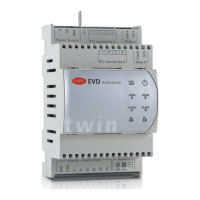ENG
“EVD Evolution TWIN” +0300006EN - rel. 2.6 - 31.01.2019
48
8.4 Variables accessible via serial
connection – driver A
Description Default Min Max Type CAREL SVP Modbus® R/W
Probe S1 reading 0 -20 (-290) 200 (2900) A 1 0 R
Probe S2 reading 0 -85(-121) 200 (392) A 2 1 R
Probe S3 reading 0 -20 (-290) 200 (2900) A 3 2 R
Probe S4 reading 0 -85(-121) 200 (392) A 4 3 R
Suction temperature 0 -85(-121) 200 (392) A 5 4 R
Evaporation temperature 0 -85(-121) 200 (392) A 6 5 R
Evaporation pressure 0 -20 (-290) 200 (2900) A 7 6 R
Hot gas bypass temperature 0 -85(-121) 200 (392) A 8 7 R
EPR pressure (back pressure) 0 -20 (-290) 200 (2900) A 9 8 R
Superheat 0 -40 (-72) 180 (324) A 10 9 R
Condensing pressure 0 -20 (-290) 200 (2900) A 11 10 R
Condensing temperature 0 -85(-121) 200 (392) A 12 11 R
Modulating thermostat temperature 0 -85(-121) 200 (392) A 13 12 R
Hot gas bypass pressure 0 -20 (-290) 200 (2900) A 14 13 R
CO
2
gas cooler outlet pressure
0 -20 (-290) 200 (2900) A 15 14 R
CO
2
gas cooler outlet temperature
0 -85(-121) 200 (392) A 16 15 R
Valve opening 0 0 100 A 17 16 R
CO
2
gas cooler pressure set point
0 -20 (-290) 200 (2900) A 18 17 R
4 to 20 mA input value (S1) 4 4 20 A 19 18 R
0 to 10 V input value (S2) 0 0 10 A 20 19 R
Control set point 0 -60 (-870) 200 (2900) A 21 20 R
Controller rmware version 0 0 800 A 25 24 R
MOP: suction temperature threshold (S2) 30 -85(-121) 200 (392) A 102 101 R/W
Discharge superheat 0 -40(-72) 180(324) A 104 103 R
Discharge temperature 0 -60(-76) 200(392) A 105 104 R
Thermal time constant NTC probe S4 50 1 800 A 106 105 R/W
MOP: High evaporation temperature threshold 50 LOP: threshold 200 (392) A 107 106 R/W
Condensation pressure for subcooling measure 0 -20(-290) 200(2900) A 108 107 R
Condensation bubble point 0 -60(-76) 200(392) A 109 108 R
Condensation liquid temperature 0 -60(-76) 200(392) A 110 109 R
Subcooling 0 -40(-72) 180(324) A 111 110 R
Liquid regulation evaporator/ condenser level percentage
0 0 100 A 116 115 R
Valve position 0 0 9999 I 4 131 R
Current unit cooling capacity 0 0 100 I 7 134 R/W
Adaptive control status - 0 10 I 75 202 R
Last tuning result 0 0 8 I 76 203 R
Extended measured probe S1 (*) 0 -2000 (-2901) 20000 (29007) I 83 210 R
Extended measured probe S3 (*) 0 -2000 (-2901) 20000 (29007) I 84 211 R
Emergency closing speed valve 150 1 2000 I 86 213 R/W
Control mode (comp. BLDC) 1 1 3 I 89 216 R/W
Type of unit for serial comm.
0 0 32767 I 94 221 R
HW code for serial comm.
0 0 32767 I 95 222 R
Reading of probe S1*40 0 -32768 32767 I 97 224 R
Reading of probe S2*40 0 -32768 32767 I 98 225 R
Reading of probe S3*40 0 -32768 32767 I 99 226 R
Reading of probe S4*40 0 -32768 32767 I 100 227 R
ALARMS
Low suction temperature 0 0 1 D 1 0 R
LAN error 0 0 1 D 2 1 R
EEPROM damaged
00 1 D32R
Probe S1 0 0 1 D 4 3 R
Probe S2 0 0 1 D 5 4 R
Probe S3 0 0 1 D 6 5 R
Probe S4 0 0 1 D 7 6 R
EEV motor error 0 0 1 D 8 7 R
Status of relay 0 0 1 D 9 8 R
ALARMS
LOP (low evaporation temperature) 0 0 1 D 10 9 R
MOP (high evaporation temperature) 0 0 1 D 11 10 R
LowSH (low superheat) 0 0 1 D 12 11 R
HiTcond (high condensing temperature) 0 0 1 D 13 12 R
Status of digital input DI1 0 0 1 D 14 13 R
Status of digital input DI2 0 0 1 D 15 14 R
Guided initial procedure completed 0 0 1 D 22 21 R/W
Adaptive control ineective 0 0 1 D 40 39 R
Mains power failure 0 0 1 D 45 44 R
Regulation backup from supervisor 0 0 1 D 46 45 R/W
Forced valve closing not completed 0 0 1 D 49 48 R/W
PROTECT.
ACTIV.
LowSH (low superheat) 0 0 1 D 50 49 R
LOP (low evaporation temperature) 0 0 1 D 51 50 R
MOP high evaporation temperature) 0 0 1 D 52 51 R
HiTcond (high condensing temperature) 0 0 1 D 53 52 R
Direct relay control 0 0 1 D 57 56 R/W
Enable LAN mode on service serial port
(RESERVED)
0 0 1 D 60 59 R/W
Tab. 8.c
(*) The displayed variable is to be divided by 100, and allows us to appreciate
the hundredth of a bar (psig).

